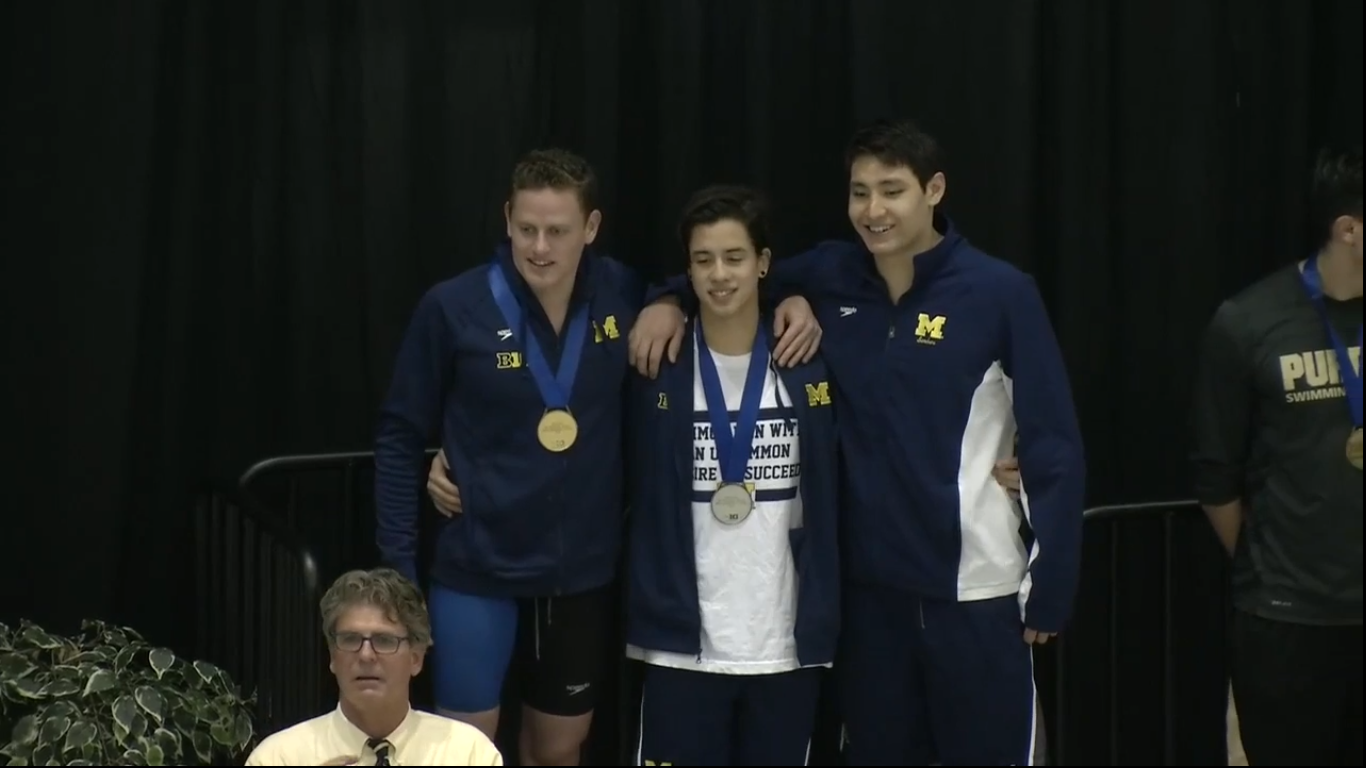M Swim wins three more titles on day 2 of the B1G Championships
On day 2 of the 2015 B1G Championships, the #5 Wolverines came up big AGAIN.
There were five events tonight in the finals. Wolverines took home the gold in 3 of them.
Dylan Bosch, the 2015 B1G Men's 200 IM Champion. Evan White with the runner-up spot and Tristan Sanders finished in 5th place.

Your 2015 B1G Men's 50-yd Freestyle Champion, Paul Powers. This event was absolutely huge Michigan in terms of points in the standings, because Michigan had 3 in the top-4 of this event. Bruno Ortiz was the runner-up in the 50 Free with Vinny Tafuto finishing in 4th place.

The final event of day 2 in Iowa City was the 400 Medley Relay. Michigan swam away with this one. BIG TIME.
Michigan set a new pool record and a new B1G Championships record with their time of 3:04.92
Aaron Whitaker went 0:46.46 on the first leg. That's the second fastest time in Michigan history.
Dylan Bosch, Richard Funk, Bruno Ortiz and Aaron Whitaker are your 2015 B1G Men's 400 Medley Relay Champions.

Michigan remains in first place after two days of competition.
February 26th, 2015 at 9:48 PM ^
Indiana's uniforms are ugly.
February 26th, 2015 at 10:11 PM ^
I think those are robes. And they are turrible.
February 26th, 2015 at 9:50 PM ^
Swimming juggernaut - when the women are up to speed, count on multiple B1G championships yearly from the swimmers.
February 26th, 2015 at 10:45 PM ^
February 26th, 2015 at 10:48 PM ^
Actually, I captured the depressing result from the 500 in the "realtime" thread."
February 26th, 2015 at 10:55 PM ^
Sent from MGoBlog HD for iPhone & iPad
February 27th, 2015 at 7:43 AM ^
Sorry for the inside swimming post, but I can't stand how the NCAA does qualifying times. "A cut"; yeah right, if you swim faster that the guy who made the finals in the Olympic Games, we'll guarantee you a spot at college national championships. A cuts are ludicrously, unrealistically fast. In addition to the example above (the B1G Champion's time in Conference finals is "too slow" to be an A cut), let me give you another. In 2012, the A cut for NCAA Division THREE (I say again, Div 3!) in the 200 backstroke was approximately the same as the U.S. Olympic Trial qualifying time. Division 3 = Olympic Trials. They are unattainable by anyone who does not expect to make the finals at NCAA championships. In contrast, B cuts are utterly meaningless. You may make a B cut, but it means nothing as far as getting to NCAAs. The NCAA will send all the swimmers who make an A cut, and then add in the swimmers with the next fastest times until they get a field that is approximately the size that they want. (Usually, there are more swimmers who didn't make the A cut than there are swimmers who do.) B cuts have nothing to do with it. Worse, once you're in the meet, you can swim any three events you want, regardless of qualifying time. As long as you swim the one event that got you to the meet, you can swim anything, regardless of whether you have a B cut or not. So, you have the absurd situation of swimming going faster than the meaningless B cut, not being invited to the meet, and watching other swimmers do their events at NCAAs, and going SLOWER than the time that wasn't good enough to get to the meet. A cuts need to be slower; B cuts need to be faster, and having a B cut in the event you enter has to be an absolute requirement to swim it at NCAAs. End of rant.
February 27th, 2015 at 8:45 AM ^
How about just take the top 40 or so times in every event. Maybe give an auto-bid to conference champions or something, provided that they make the "B" cut? I don't know, I'm just a guy.
February 27th, 2015 at 10:34 AM ^
It looks like that's what ends up happening in real life.
The NCAA mandates exactly 235 swimmers in the championship. So they take a number of swimmers in each event that will get them to 235 total. Last year it was the top 30 in each individual event.
So even though there are only 6-10 "A" times reached a year in each event, it looks like if you are in the top 30, you are in. And, as MadMatt points out, once you are in you can enter other events as well (maximum 3) as long as you also enter an event in which you qualified.
So to take one event as an example from last year, in the 500 Freestyle--
There were 10 "A" times. So they also took the top 20 "B" times to complete the 30-swimmer "automatic" entries for that event. In addition to those 30 automatic entries, another 25 swimmmers (who qualified automatically in other events) entered the 500 Freestyle.
It really seems MadMatt is correct. There were only 10 "A" times all season, although they needed 30 automatic entries for the event. There were 112 "B" times all season, but only 43 of those 112 swimmers even competed in the event at the NCAAs. So clearly there should be more "A" times and fewer "B" times when they set the qualifying standards.
